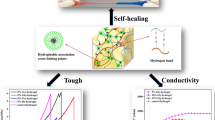Abstract
Gels are an important class of soft and wet materials having superior properties with diverse applications in tissue engineering, bio-medical engineering, and electrochemistry. In order to accelerate the development of gels, it is required to synthesize multi-functional gels of high mechanical strength, ultra low surface friction and suitable elastic modulus with a variety of methods and new materials and investigate their internal structure to ensure the best implementation to any suitable fields. Among many types of gels, ionic gels made from ionic liquids (ILs) will be possibly used for diverse applications in electrochemical devices as sensors, actuators, batteries and in the field of tribology. ILs are characterized by many unique physico-chemical properties which make them a potential candidate for gel materials. In the present work a novel approach for preparing Ionic double-network gels (iDN gels) using IL have been synthesized utilizing photo-polymerization process. A hydrophobic monomer methyl methacrylate has been used as a first network and a hydrophobic IL monomer, N,N-diethyl-N-(2-mthacryloylethyl)-N-methylammonium bistrifluoromethylsulfonyl)imide has been used as a second network. The resulting iDN gels show transparency, flexibility and good mechanical toughness. An attempt to determine the mesh size of the iDN gels has been made for the first time to understand the internal structure of the ionic liquid based gels by scanning microscopic, light scattering. Three types of crosslinking densities of the iDN gels were experimentally determined from the size of internal structure, solvent content and Young’s modulus. By comparing the three mesh densities, the relation between the network structure and mechanical properties of the gels is discussed. We compared the crosslinking densities of the iDN gels and conventional hydrogels to understand the network structure of the iDN gels and discussed its difference of structural behavior from that of hydrogels.








Similar content being viewed by others
References
Furukawa H, Horie K, Nozaki R, Okada M (2003) Swelling induced modulation of static and dynamic fluctuations in polyacrylamide gels observed by scanning microscopic light scattering. Phys Rev E 68:031406-1-14
Furukawa H, Hidema R, Takada H, Amano Y, Kabir MH, Gong J (2013) Smart hydrogels developed with inter-crosslinking network (ICN) structure. J Solid Mech Mater Eng 7(2):245–250
Gong JP, Katsuyama Y, Kurokawa T, Osada Y (2003) Double-network hydrogels with extremely high mechanical strength. Adv Mater 15:1155–1158
Holbrey JD, Seddon KR (1999) Ionic liquids. Clean Prod. Process 1:223–226
Huang M, Furukawa H, Tanaka Y, Nakajima T, Osada Y, Gong JP (2007) Importance of entanglement between first and second components in high-strength double network gels. Macromolecules 40:6658–6664
Morita M, Shirai T, Yoshimoto N, Ishikawa M (2005) Ionic conductance behavior of polymeric gel electrolyte containing ionic liquid mixed with magnesium salt. J Power Sources 139:351–355
Okeyoshi K, Abe T, Noguchi Y, Furukawa H, Yoshida R (2008) Shrinking behavior of surfactant-grafted thermosensitive gels and the mechanism of rapid shrinking. Macromol Rapid Commun 29:897–900
Pandey G, Kumar PY, Hashmi SA (2010) Ionic liquid incorporated polymer electrolytes for surpercapacitor application. Indian J Chem 49A:743–751
Plechkova NV, Seddon KR (2008) Applications of ionic liquids in the chemical industry. Chem Soc Rev 37:123–150
Rubinstein M, Colby R (2003) Polymer physics. Oxford University Press, Oxford
Sato T, Masuda G, Takagi K (2004) Electrochemical properties of novel ionic liquids for electric double layer capacitor applications”. Electrochim Acta 49:3603–3611
Sato T, Marukane S, Narutomi T, Akaob T (2007) High rate performance of a lithium polymer battery using a novel ionic liquid polymer composite”. J Power Sources 164:390–396
Seddon KR (2003) Ionic liquids: a taste of the future. Nat Mater 2:363–365
Sekhon SS, Park JS, Cho E, Yoon YG, Kim CS, Yamada K (2006) Physicochemical properties of proton conducting membranes based on ionic liquid impregnated polymer for fuel cells. J Mater Chem 16:2256–2265
Susan MABH, Kaneko T, Noda A, Watanabe M (2005) Ion gels prepared by in situ radical polymerization of vinyl monomers in an ionic liquid and their characterization as polymer electrolytes. J Am Chem Soc 127:4976–4983
Takada G, Hidema R, Furukawa H (2012a) Ultrahigh ductile gels developed by inter cross-linking network (ICN). J Solid Mech Mater Eng 6(2):169–177
Takada G, Hidema R, Furukawa H (2012b) Ultrahigh ductile gels having inter-crosslinking network (ICN) structuree”. J Surf Sci Nanotech 10:346–350
Wasserscheid P, Keim W (2000) Ionic liquids—new solutions for transition metal catalysis. Angew Chem Int Ed 39:3772–3789
Welton T (1999) Room-temperature ionic liquids. solvents for synthesis and catalysis. Chem Rev 99:2071–2084
Acknowledgments
This work is supported by the national project named “Green Tribology Innovation Network”, in area of Advanced Environmental Materials, Green Network of Excellence (GRENE), sponsored by the Ministry of Education, Culture, Sports, Science and Technology (MEXT) in Japan.
Author information
Authors and Affiliations
Corresponding author
Rights and permissions
About this article
Cite this article
Ahmed, K., Watanabe, Y., Higashihara, T. et al. Investigation of mechanical properties and internal structure of novel ionic double-nework gels and comparison with conventional hydrogels. Microsyst Technol 22, 17–24 (2016). https://doi.org/10.1007/s00542-015-2630-4
Received:
Accepted:
Published:
Issue Date:
DOI: https://doi.org/10.1007/s00542-015-2630-4




